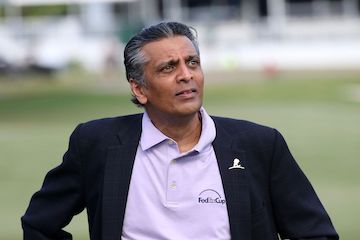FedEx Corp.’s new chief executive officer, Raj Subramaniam, had plenty to contend with when he took over from package-delivery legend Fred Smith this month. Now he’ll have to roll out his growth strategy to a board that includes not only Smith, but new faces from an activist hedge fund as well.
After years as Smith’s understudy, Subramaniam will tell investors June 29 how he intends to lead FedEx while confronting higher costs for labor, Covid-related lockdowns in China and angry contractors at its crown-jewel FedEx Ground unit.

The large dividend “leads me to think they’ve got really strong insight into where their business is going and what their cash flow is going to look like,” said Trip Miller, a managing partner at Gullane Capital Partners and FedEx investor. “Maybe under Raj, he’s setting the bar a little bit higher for himself and the team to meet. I like that.”
FedEx shares rose 1.8% at 9:50 a.m. Tuesday in New York. The stock has risen about 4.1% this month, compared with a 9.2% drop for the S&P 500 index.
The company is forecast to report record quarterly profit on June 23 of $6.87 a share, the average analyst estimate in a Bloomberg survey. For investors, that would be a welcome change after several years of missed targets, declining margins, spotty free cash flow and large expenditures. They’ll look for signs of progress in both the results and in Subramaniam’s comments a few days later at FedEx’s first investor meeting in a decade in its hometown of Memphis, Tennessee.
Investors will inevitably compare Subramaniam’s performance to Carol Tome, who took over as United Parcel Service Inc.’s CEO in June 2020 during the height of the pandemic. Tome has increased UPS’s profit margins by raising prices, focusing on more-profitable small customers and cutting costs. In the last four complete quarters, UPS’s operating profit margin was 13.5%, roughly double the 6.7% for FedEx.
Subramaniam, 56, has to balance a drive to boost profit with a need to keep peace in the rank-and-file: namely, about 6,000 small companies that own the trucks and hire the drivers that deliver 10 million packages every day.
The FedEx Ground unit that these small contractors serve has been the engine for most of the company’s profit growth for two decades, and it’s likely to play an even more important role if executives heed investor demand to combine it with the separately operated FedEx Express.
Contractor Woes
Satish Jindel, a parcel consultant and founder of industry-data collector ShipMatrix, expects Subramaniam to gradually increase the number of Express packages that are handed off to Ground until the two distinct networks operate mostly as one. The shift will give the Ground unit more volume, improving the economics for contractors, Jindel said.
The delivery contractors, many with as few as five trucks and a handful of large ones with a couple hundred vehicles, have been whipsawed by changes FedEx put in place to cope with fast-growing e-commerce packages, disrupting services originally built mainly for business-to-business deliveries.
The pandemic-driven volume surge exposed weaknesses at FedEx Ground. Those issues included its struggles to hire enough workers to sort and load packages onto the contractors’ vehicles each morning, as well as software that failed to accurately predict the next day’s volume. Higher costs for fuel, drivers and maintenance are squeezing contractors.
“When you have disgruntled people, you often have high turnover. And if you have high turnover, you potentially have issues being able to meet delivery commitments,” said Helane Becker, an analyst with Cowen & Co. “It’s definitely problematic.”
Profit Goals
Beyond the FedEx Ground issues, Subramaniam is on the hunt for additional profit. Jindel said the spending reductions may come mostly from new airplanes, with FedEx potentially giving up some of the Boeing Co. aircraft that are pending delivery.
To keep cash flow steady, Subramaniam also needs to increase margins at FedEx Express and finally reap the benefit from FedEx’s $4.9 billion acquisition in 2016 of European courier TNT Express, which only recently has fully combined its operations with FedEx’s.
The new CEO will have to crack the conundrum of lower-margin e-commerce packages growing faster than commercial deliveries. FedEx has invested in automation, boosted prices, focused on small business and extended its service to seven days a week. Even so, profit margins have declined to 10% or less over the last few years from a peak of 18% in 2012.
“They’ve broadly done the right things,” said William Fitzalan Howard, an analyst with Berenberg. But the effort seems “a bit sound-bitey to me because it clearly hasn’t actually worked.”
Smith’s Role
The pressure on Subramaniam will also come from Smith, who will have a large voice in how to run FedEx as executive chairman and as the largest shareholder with a 7.5% stake. (D.E. Shaw agreed to limit its stake to no more than 7.5%). Smith built the company from a few business jets converted to carry packages in 1973 to a global courier with $90 billion of sales.
Before naming Subramaniam as his successor, Smith appointed his son, Richard, 44, to head up the Express business, the largest unit by sales. Jindel said the idea is for Subramaniam, a 30-plus year veteran at FedEx, to put the company on a growth path and pave the way for Richard Smith to become chief operating officer and then eventually CEO.
“I don’t think a lot of big changes happen unless Fred wants them to happen,” said Miller, the investor.




_-_127500_-_fd58817006781b0655e77d342459c13ff31c7a97_yes.png)






